Waterponding – Bringing Bare Earth Back to Life
Host: Mel McDonald – Rangeland NRM
Written by Mel McDonald – Kimberley Project Manager, Rangelands NRM.
Previous to this project, if someone had told me that we could transform scaled land with a close resemblance to concrete to knee high vegetation in just a few months, I would have told them they were dreaming! However, that is just what has been achieved in the Fitzroy River Catchment in the Kimberley using a technique called waterponding.
I was fortunate enough to become involved in this project after much of the hard work had been done and the winning formula was just about to be discovered. Kevin and Wendy Brockhurst from Larrawa Station in the East Kimberley were working with Matt Fletcher from the Department of Agriculture WA (DAFWA) on an Producer Demonstration Site (PDS) to ‘Investigate the practicality of regenerating degraded pastoral land’ funded by Meat and Livestock Australia (MLA).
“The area being regenerated was eroded early in the 1970s as a result of overgrazing, causing the loss of topsoil and the formation of a small gully. The site was in poor condition with no perennial and minimal annual vegetation present. While subsequent management strategies, such as excluding stock, had resulted in some regeneration of native species, few palatable and perennial species had returned.” (Quoted from: http://futurebeef.com.au/resources/newsletters/futurebeef-ebulletin/larrawa-station-producer-demonstration-site-3/ )
Two years of trialling various techniques using a 12G grader had produced positive, but not overwhelming results. A 12G is the sized grader that is commonly owned by Stations for maintaining their roads and fence lines. It was decided that to obtain conclusive results, a larger powered grader (16G) needed to be trialled. These graders are commonly used to maintain public roads so a contractor needed to be bought in for the job. It was also desirable for Ray Thompson from the Central West Catchment Management Authority (CMA) in Nyngan, NSW, to assist. Ray uses 16G graders for the rehabilitation technique called ‘waterponding’ which he has refined over the last 30+ years.
With the kitty running low, Kevin and Matt applied to Rangelands NRM for further financial assistance under a Grant Scheme to protect the Fitzroy River Catchment. That was when I became involved. It was a huge success with a 20 per cent increase in vegetation cover in the first wet season! The plants that came back that first year were not what you would call cattle feed, but instead were primary colonisers.
A paddock walk after that first wet season attracted people from all over the Kimberley. Conversations on that day led to the development of a project to undertake waterponding on three neighbouring properties with a fourth subsequently became involved. This project was large enough for Ray to bring his custom survey equipment across from NSW and to negotiate a good deal with a local grader contractor. In this project we were able to get much better than a 20 per cent increase in ground cover in the first year. I will let the pictures below tell the rest of the story:
 Ray Thompson (Central West CMA) setting up his custom survey equipment for marking waterponds.
Ray Thompson (Central West CMA) setting up his custom survey equipment for marking waterponds.
 A 16G grader goes back and forward three times to build the bank of the waterpond high enough to pond enough water long enough to achieve rehabilitation.
A 16G grader goes back and forward three times to build the bank of the waterpond high enough to pond enough water long enough to achieve rehabilitation.
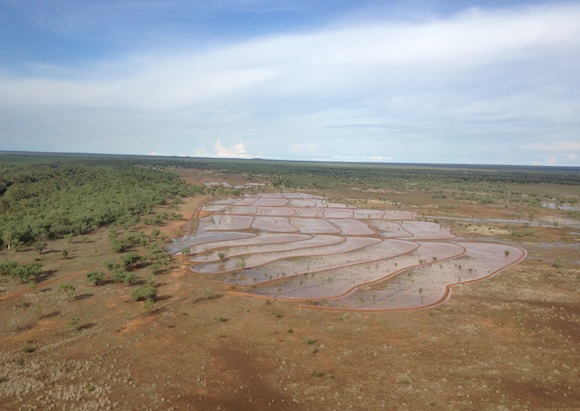 Water is held on the clay pan by the bank of the waterpond giving it time to soak in which opens up the clay and allows vegetation to establish.
Water is held on the clay pan by the bank of the waterpond giving it time to soak in which opens up the clay and allows vegetation to establish.
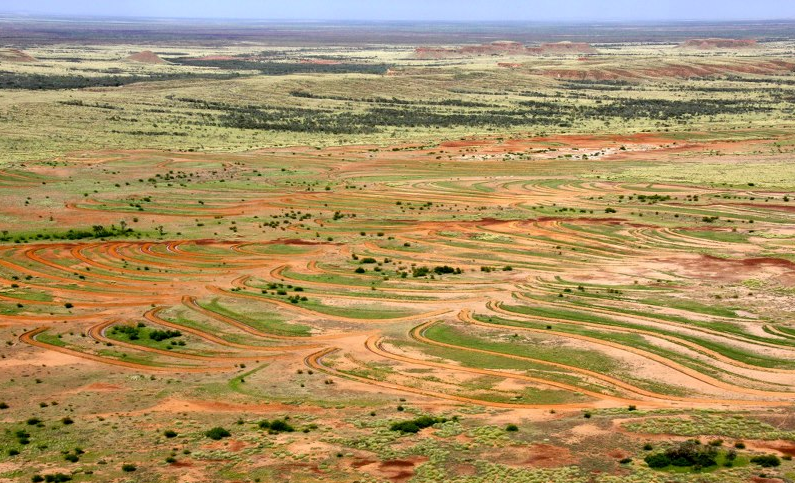 Aerial view on Bulka Station taken only half way through the first wet season following waterponding. The green vegetation can be seen starting to come into the lower part of the ponds where the water has been allowed to soak in (Photo by Felicity Brown).
Aerial view on Bulka Station taken only half way through the first wet season following waterponding. The green vegetation can be seen starting to come into the lower part of the ponds where the water has been allowed to soak in (Photo by Felicity Brown).
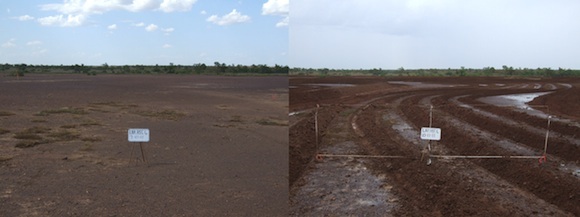 Waterponding Monitoring point LAR REG 4 before and after building a waterpond around it and using an opposed disc plough through the middle: 7/11/2011 & 10/11/2011 (Photos by Mathew Fletcher, DAFWA).
Waterponding Monitoring point LAR REG 4 before and after building a waterpond around it and using an opposed disc plough through the middle: 7/11/2011 & 10/11/2011 (Photos by Mathew Fletcher, DAFWA).
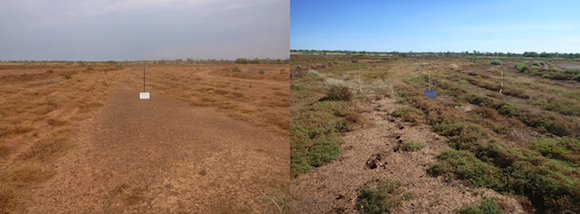 Waterponding Monitoring point LAR REG 4: 25/10/2012 & 13/04/2013. In the second picture the lighter patches are grasses starting to move into the site.
Waterponding Monitoring point LAR REG 4: 25/10/2012 & 13/04/2013. In the second picture the lighter patches are grasses starting to move into the site.
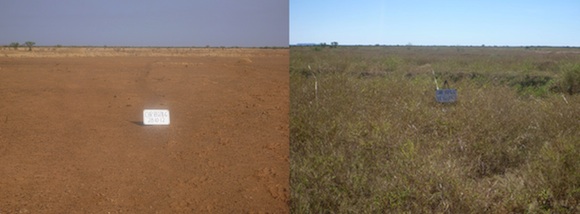 Monitoring point CHR REG 6 before and after waterponding: 28/10/2012 & 13/04/2013.
Monitoring point CHR REG 6 before and after waterponding: 28/10/2012 & 13/04/2013.
